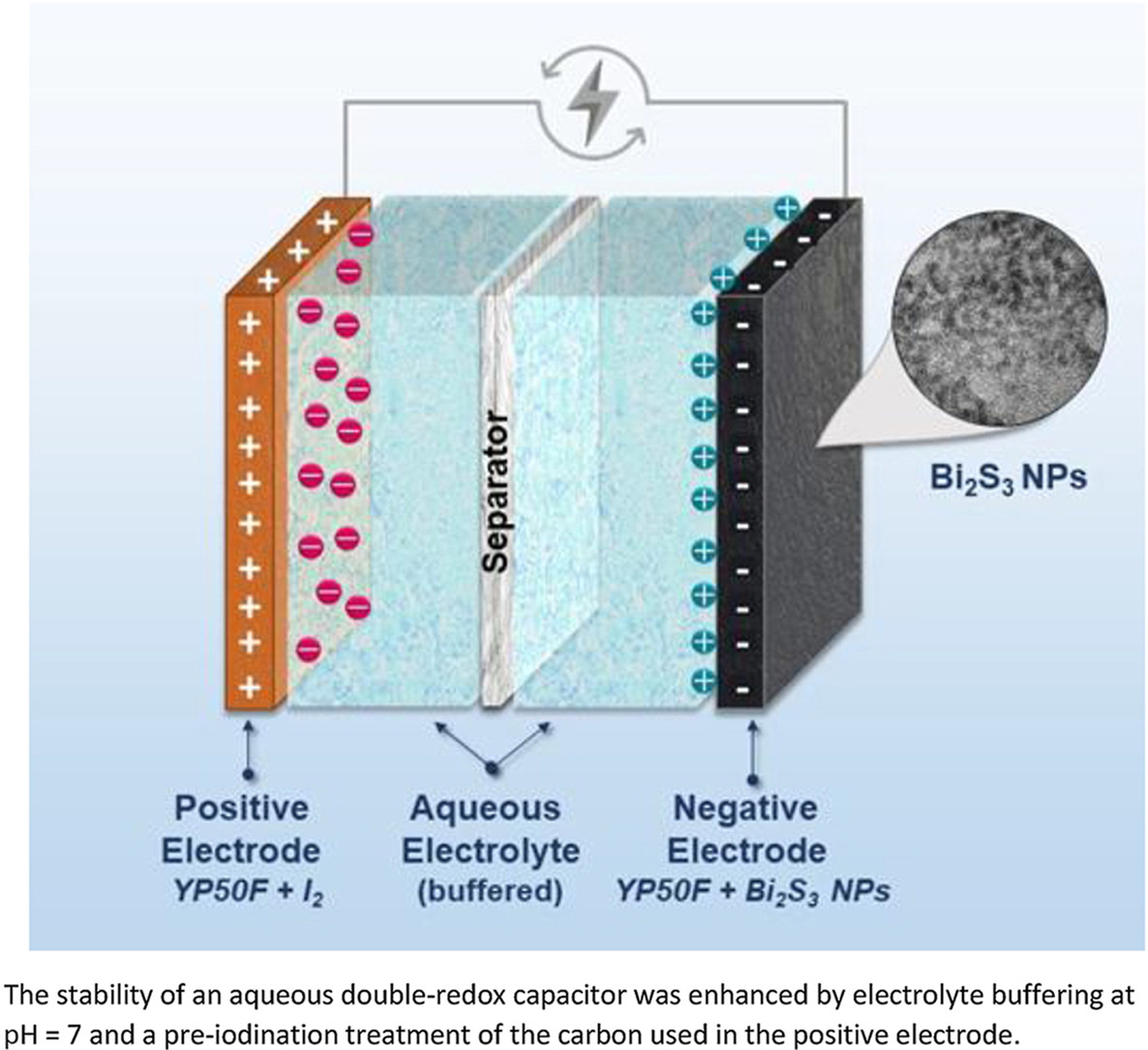Aragonese scientists make progress on a green alternative to the energy crisis
Researchers from the Aragon Nanoscience and Materials Institute (INMA, a joint institute of the CSIC and UNIZAR) have published a pioneering study in the Journal of Power Sources
The study proposes new strategies to improve the performance and stability of aqueous supercapacitors, key devices for sustainable energy storage
Zaragoza, 29 September. Researchers at the Institute of Nanoscience and Materials of Aragon (INMA, a joint institute of the CSIC and the University of Zaragoza) have published a pioneering study in the prestigious Journal of Power Sources that proposes new strategies to improve the performance and stability of aqueous supercapacitors, key devices for sustainable energy storage.
Given the growing demand for energy and the limitations of fossil fuels, renewable energies require more efficient and safer storage systems. Alongside the well-known lithium-ion batteries used in electric vehicles and mobile devices, more economical and environmentally friendly alternatives are being researched. In this context, aqueous supercapacitors are emerging as one of the most promising and green options.
Unlike conventional batteries, supercapacitors can be charged and discharged in a matter of seconds, making them an ideal alternative for applications such as trams or hybrid cars, as they can quickly supply and recharge energy at stops or charge themselves using regenerative braking. However, their storage capacity remains lower than that of rechargeable batteries, especially when aqueous electrolytes are used instead of organic solvents. Organic solvents allow higher voltages to be applied than water, enabling the device to store more energy. However, aqueous electrolytes are less toxic, flammable or harmful to the environment and are also cheaper.
In this context, researchers from INMA (CSIC-Unizar), in collaboration with Poznań University of Technology (PUT) in Poland, have developed high-energy, stable aqueous supercapacitors using nanomaterials.
Specifically, the research is led by María Bernechea Navarro (ARAID researcher at the University of Zaragoza at INMA), María Pilar Lobera González (contracted professor at the University of Zaragoza at INMA); and Sergio Aina and Abdenbi Cherkaoui, researchers at the University of Zaragoza in the Nanoporous Films and Particles (NFP) research group at the Aragon Nanoscience and Materials Institute(INMA).
Carbon hybrid materials and nanoparticles
The team has developed a series of nanomaterials combining 4 nanometres bismuth sulphide nanoparticles and commercial carbon materials. These new nanocomposites can be used as supercapacitor electrodes and their storage capacity is significantly greater than that of conventional carbon materials.
In addition, it has been shown that an aqueous sodium iodide electrolyte generates a synergistic effect with the nanoparticles, doubling or tripling the stored energy compared to conventional aqueous systems. While the nanoparticles act on the negative electrode, the iodide acts on the positive electrode, thus optimising the performance of the device.
Improving stability
Stability is the main problem of these systems involving chemical reactions, as they can reduce the device’s lifetime after multiple charge and discharge cycles. To solve this problem, two complementary strategies have been tested: the first is the incorporation of iodine into the carbonaceous material used in the positive electrode. The second is the addition of a neutral buffer to the electrolyte.
Both approaches have proven to be highly effective and have enabled supercapacitors that maintain their properties intact after more than 1,000 cycles of use. These treatments improve the reversibility of electrochemical reactions and prevent the formation of harmful by-products, prolonging the stability and reliability of the devices.
This work has received funding from the M-ERA.NET network (NOEL project: Innovative Nanostructured Electrodes for Energy Storage Concepts) through MICIU/AEI/10.13039/501100011033 (Ref: PCI2019–10363), MICIU/AEI/10.13039/501100011033 and ‘FEDER/EU’ (Ref. PID2023-150574NB-I00), MICIU/AEI/10.13039/501100011033 and European Union NextGenerationEU/PRTR promoted by the Government of Aragon (Ref: PRTR-C17. I1), MICIU/AEI/10.13039/501100011033 (Ref. CEX2023-001286-S) and the Government of Aragon (Call for pre-doctoral contracts 2023-2027).
Link to the scientific publication
“Enhanced stability of high energy aqueous capacitor based on redox-active nanomaterials and electrolyte”
DOI: 10.1016/j.jpowsour.2025.238098
Sergio Aina, Adam Slesinski, Abdenbi Cherkaoui, Sylwia Slesinska, M. Pilar Lobera, Elzbieta Frackowiak, María Bernechea
Available online: 18th Aug. 2025
Journal of Power Sources, Volume 657, 30 November 2025, 238098
INMA: Severo Ochoa Centre of Excellence
In 2024, the Aragon Nanoscience and Materials Institute (INMA) became the first research centre in the region to receive Severo Ochoa Centre of Excellence accreditation. This recognition entails funding of €4,500,000 and the awarding of five pre-doctoral contracts for the period 2024–2028, in addition to the ten that were awarded in the previous call for applications.
INMA has an integrative approach that translates research into nanomaterials into solutions for society’s challenges. The institute currently has around 300 members and more than 40 European projects underway. It publishes an average of 300 papers per year and has obtained €7 million in competitive public funding.
In addition to having created numerous technology-based companies, four of which are active, it has 15 valid patents, five of which are licensed. INMA works closely with industry. All this provides around one million euros in annual revenue.
For more information and interviews: 699 498089
29-09-2025









